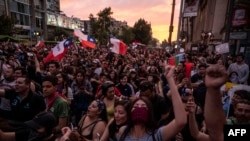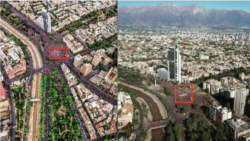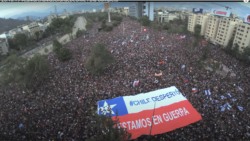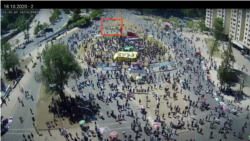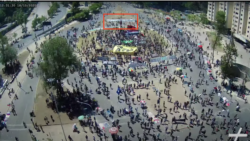October 2020 marked the one-year anniversary of widespread anti-government protests in Chile, when millions of people took to the streets over growing inequality in the country.
And on October 18, 2020, Patricia Villegas Marin, the president of the Venezuelan government-funded broadcast network, teleSUR, posted a photo on Twitter and wrote: "Santiago de Chile. October 18, 2020. One year after the popular mobilization."
The tweet is incorrect. The photo Marin posted actually was from protests in 2019.
Marin’s colleague, Paola Dragnic (a correspondent of teleSUR), vehemently defended its authenticity even as other Twitter users raised questions of misrepresentation.
Chile's president, Sebastian Pinera has been a vocal opponent of Venezuela’s socialist leader Nicholas Maduro and his government, and vice-versa. In January 2019, Pinera joined the United States and other countries in recognizing Venezuelan opposition leader Juan Guaido as the country’s president after a disputed election.
And in April, Pinera said on Twitter: “We reiterate our full support for President Guaido and democracy in Venezuela. Maduro's dictatorship must end by the peaceful force, and within the constitution of the Venezuelan people. This will restore freedom, democracy, human rights and progress in #Venezuela."
To be sure, Pinera has been the target of persistent protests. In early October 2019, a 4 percent fare increase in Chile’s capital, Santiago de Chile, metro system ignited mass demonstrations over economic and other inequalities. Students used social media to organize rallies against transit fares, occupying and rioting at stations and later taking unrest to the streets.
As demonstrations grew, Pinera called for a state of emergency and sent troops to respond. Pinera imposed curfews nationwide – but he also rolled back the fare increase and promised to address economic issues. The moves failed to quell longstanding grievances. “It’s not 30 pesos, it’s 30 years,” one protest slogan goes.
A year after demonstrations began, they have resumed with smaller crowds.
The photo posted by Marin is from Plaza Baquedano, in the capital, Santiago de Chile. Marin’s post was then retweeted by Venezuela’s minister of foreign affairs, Jorge Arreaza, and by Maduro himself.
Half an hour after her post, another Twitter user commented that the photo was from 2019, to which Dragnic responded by publishing a different photo from the square, saying “No ma'am, it's not 2019.” Dragnic went on to publish the same photo as a rebuttal to a different user who also disputed the date.
Polygraph.info examined both photos by Marin and Dragnic and found them to be from different years.
Each photo shows an object extending out from the crowd. In the photo on the left (below, from Marin’s original tweet) Chile’s flag stands out – whereas the photo on the right (below, from Dragnic) shows a white banner.
The same flag was visible during mass gatherings in Baquedano Square on October 25, 2019, (as seen in this video). On that day, an estimated 1 million people marched in Chile’s capital, Santiago, calling for, among other things, Pinera's resignation. That day marked the largest gathering to date.
Galeria CIMA, an art gallery in Santiago located by Baquedano Square – and which has started to broadcast livestreams of the plaza since October 2019 – captured both events in 2019 and 2020.
At the 4:23 hour mark in the 2019 video, a large Chilean flag is set up by the crowd in the bottom center of the frame, with writing saying "#Chile desperto” (“Chile woke up”) and “#no estamos en guerra” (“we are not at war”). The flag then makes its way further into the crowd.
A reverse image search shows the exact photo Marin published circulating on social media last year. It was published in a tweet from October 26, 2019, stating, “More than 1 million people got together to be part of the largest march in the history of Chile. Oct 25, 2019. Chile fights for its future,” as well as in an October 27 post on 9gag, the Hong Kong-based, user-generated social platform.
In Galeria CIMA's 2020 video, people appear at the top of the video frame at around 12:30 p.m. (34:09 in the video) with the distinct white banner.
A minute later, the banner is erected. The stream also shows considerably fewer people in 2020 when compared with the 2019 demonstration.
Maduro himself tweeted a video on October 26, 2019, showing the protests on the capital’s square, writing that “the prophecy of Salvador Allende and Víctor Jara was fulfilled, the wide avenues have been opened, through them free men and women who rebel against the neoliberalism that oppresses and generates inequality pass. Long live Chile! Long live the Great Homeland!”
Salvador Allende was a Marxist politician and the 28th president of Chile, having won the 1970 elections. His presidency, however, did not please then president Richard Nixon — who ordered the CIA to oust him. Jara was a Chilean activist-folk singer who was killed after the coup that installed Gen. Augusto Pinochet.
On September 11, 1973, the military junta led by Pinochet seized power and ended three years of socialist rule. Allende killed himself as troops stormed the presidential palace.
Chile’s Pinera was the first conservative president to rule the country since the end of its dictatorship in 1990. He was first elected in 2010 and served for four years until being replaced by socialist Michelle Bachelet. Pinera was re-elected in 2018.




